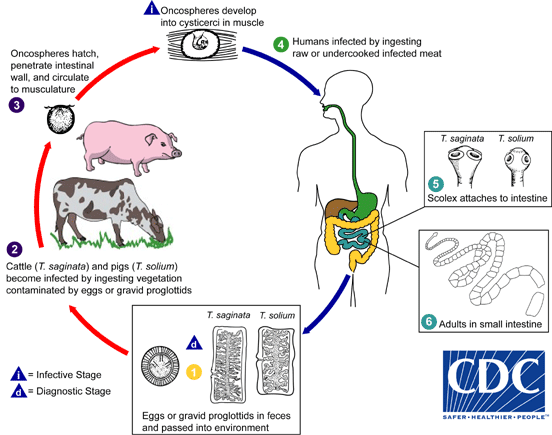Classification, Habitat and geographical distribution, Life cycle of Taenia solium, Clinical manifestation of Taeniasis, Laboratory Diagnosis, Treatment, Prevention and Control
Taeniasis
- Phylum – Platyhelminthes
- Class – Cestoda
- Genus – Taenia
- Species – T. solium, T. saginata
Taeniasis in humans is a parasitic infection caused by the tapeworm species Taenia saginata (beef tapeworm), Taenia solium (pork tapeworm).Humans can become infected with these tapeworms by eating raw or undercooked beef (T. saginata) or pork (T. solium). Cystecerci eggs are the infective form of parasite. Taenia solium tapeworm infections can lead to cysticercosis, which is a disease that can cause seizures. Eating raw or undercooked beef or pork is the primary risk factor for acquiring taeniasis.
Habitat and geographical distribution
They reside in the small intestine of the host.
Taenia are found worldwide,with T. saginata having higher occurance. Infections with T. saginata occur wherever contaminated raw beef is eaten, particularly in Eastern Europe, Russia, eastern Africa and Latin America.
Life cycle of Taenia

Humans are the only definitive hosts for T. saginata and T. solium. Eggs or gravid proglottids are passed with feces; the eggs can survive for days to months in the environment. Cattle (T. saginata) and pigs (T. solium) become infected by ingesting vegetation contaminated with eggs or gravid proglottids. In the animal’s intestine, the oncospheres hatch, invade the intestinal wall, and migrate to the striated muscles, where they develop into cysticerci. A cysticercus can survive for several years in the animal.
Humans become infected by ingesting raw or undercooked infected meat. In the human intestine, the cysticercus develops over 2 months into an adult tapeworm, which can survive for years. The adult tapeworms attach to the small intestine by their scolex and reside in the small intestine. Length of adult worms is usually 5 m or less for T. saginata (however it may reach up to 25 m) and 2 to 7 m for T. solium. The adults produce proglottids which mature, become gravid, detach from the tapeworm, and migrate to the anus or are passed in the stool (approximately 6 per day). T. saginata adults usually have 1,000 to 2,000 proglottids, while T. solium adults have an average of 1,000 proglottids. The eggs contained in the gravid proglottids are released after the proglottids are passed with the feces. T. saginata may produce up to 100,000 and T. solium may produce 50,000 eggs per proglottid respectively.
Clinical manifestation of Taeniasis
Most people with tapeworm infections have no symptoms or mild symptoms. Patients with T. saginata taeniasis often experience more symptoms that those with T. solium because the T. saginata tapeworm is larger in size (up to 10 meters (m)) than T. solium (usually 3 m). Tapeworms can cause digestive problems including abdominal pain, loss of appetite, weight loss, and upset stomach. The most visible symptom of taeniasis is the active passing of proglottids (tapeworm segments) through the anus and in the feces. In rare cases, tapeworm segments become lodged in the appendix, or the bile and pancreatic ducts.
Infection with T. solium tapeworms can result in human cysticercosis, which can be a very serious disease that can cause seizures and muscle or eye damage.
Laboratory diagnosis of Taeniasis
i. Demonstration of eggs in stool by:
a. Microscopy – wet mount method using saline
b. Concentration method – sedimentation technique, formalin – ether technique
c. Anal swab – detection of egg from anal area using swab
ii. X-ray of skull and soft tissue may reveal calcified cystecerci.
iii. CT scan of brain accurately locates the lesion.
iv. Serological tests – IHI, IFA, ELISA; to detect antibodies in the serum against the parasite.
v. PCR
Treatment, prevention and control
- – Oral medication: praziquantel or niclosamide
- Mepacrine (atebrin)
- – One way to prevent taeniasis is to cook meat to safe temperatures.
- – proper sanitary disposal of feces.
- – cattle should not be allowed to graze in the field polluted by human feces or sewage;leads to infection control in cattle.
- -personal hygiene; general sanitary measures
- – avoid eating raw vegetables grown in soil irrigated by sewage water.
- -inorder to break the parasitic life, infected person should be treated.